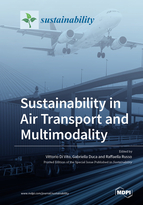Sustainability in Air Transport and Multimodality
A special issue of Sustainability (ISSN 2071-1050). This special issue belongs to the section "Sustainable Transportation".
Deadline for manuscript submissions: closed (31 July 2022) | Viewed by 19195
Special Issue Editors
Interests: air traffic management; air traffic optimization; autonomous flight systems; detect and avoid; remotely piloted aircraft systems (RPAS); urban air mobility (UAM); aviation operations sustainability
Special Issues, Collections and Topics in MDPI journals
Interests: Human factors integration; social sustainability; safety culture; inclusive design
Special Issue Information
Dear Colleagues,
The aim of this Special Issue is to provide researchers in the field of air transport and multimodal transport with a place to share their ideas and results about their latest research and development activities. The addressed topic has been of relevant importance in recent years, given the increasing attention that is devoted to sustainability aspects in aviation and to the emerging need to achieve multimodality in transportation by integrating the vertical dimension with the horizontal one in particular in urban and peri-urban environments. The topic, therefore, also includes new concepts of urban air mobility (UAM), advanced air mobility (AAM), unmanned traffic management (UTM), and U-space, which are emerging as new perspective paradigms for transport and flying traffic management in the future cities, which in turn will have to implement proper actions to adapt their urban structure to host new infrastructure, enabling new mobility forms, both on the surface and in the air.
The research community is considering new technologies and concpets regarding the implementation of seamless door-to-door travel, which requires the implementation of fully integrated intermodal transport systems, allowing passengers easy and seamless transfer between different transport modes, where air traffic management (ATM) and air transport can play a fundamental role. In this framework, the new paradigm from the ATM perspective is one of shifting from the optimization of the air segment of the journey to the optimization of the overall journey, including not only the air segment but also the surface and even water transport segments.
Through such a new global optimization paradigm, it will be possible to increase the efficiency of the overall transport chain by improving the interoperability of the different modes of transport, while at the same time increasing environmental, social and economic sustainability, whose complementary implications are of the utmost importance today and will become more and more fundamental in the future, making more efficient use of existing and future infrastructure.
To be more precise, the topics covered in this Special Issue include (but are not limited to) the following: air traffic management (ATM), advanced air mobility (AAM), unmanned traffic management (UTM) and U-space, urban air mobility (UAM), sustainability in transportation, multimodal transport, integrated transport services, digitalisation in multimodal transport management, data sharing in multimodal transport, automation in vertical and surface transport vehicles, algorithmic governance, and new paradigms and infrastructure in air, rail, and water transport.
Dr. Vittorio Di Vito
Dr. Gabriella Duca
Raffaella Russo
Guest Editors
Manuscript Submission Information
Manuscripts should be submitted online at www.mdpi.com by registering and logging in to this website. Once you are registered, click here to go to the submission form. Manuscripts can be submitted until the deadline. All submissions that pass pre-check are peer-reviewed. Accepted papers will be published continuously in the journal (as soon as accepted) and will be listed together on the special issue website. Research articles, review articles as well as short communications are invited. For planned papers, a title and short abstract (about 100 words) can be sent to the Editorial Office for announcement on this website.
Submitted manuscripts should not have been published previously, nor be under consideration for publication elsewhere (except conference proceedings papers). All manuscripts are thoroughly refereed through a single-blind peer-review process. A guide for authors and other relevant information for submission of manuscripts is available on the Instructions for Authors page. Sustainability is an international peer-reviewed open access semimonthly journal published by MDPI.
Please visit the Instructions for Authors page before submitting a manuscript. The Article Processing Charge (APC) for publication in this open access journal is 2400 CHF (Swiss Francs). Submitted papers should be well formatted and use good English. Authors may use MDPI's English editing service prior to publication or during author revisions.
Keywords
- air traffic management (ATM)
- door-to-door transport
- urban air mobility (UAM)
- advanced air mobility (AAM)
- unmanned traffic management (UTM)
- U-space
- multimodal transport concept of operations (ConOps)
- intermodal transport
- passenger experience
- journey optimization
- air transport
- surface transport
- rail transport
- water transport







